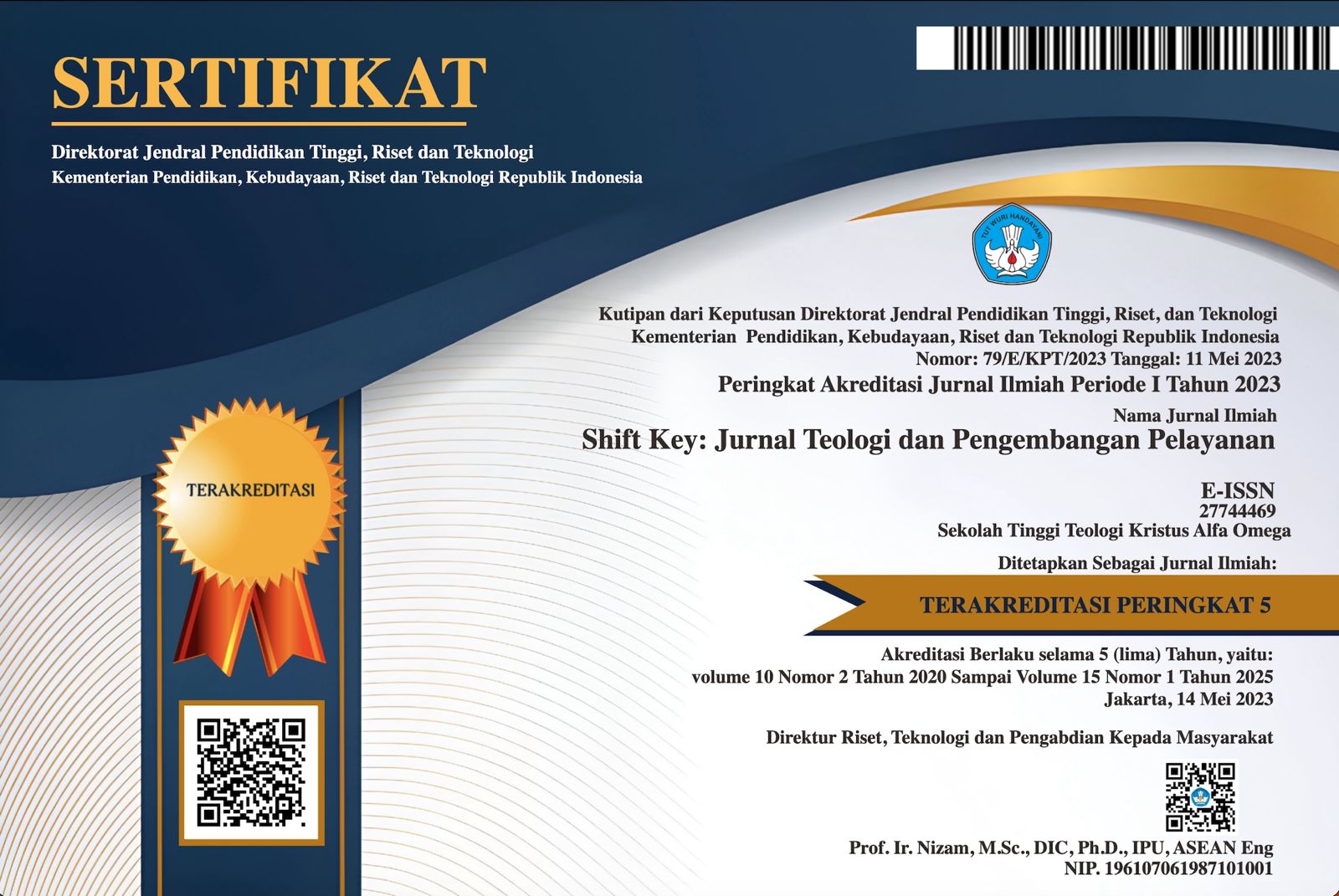PENGGUNAAN GAYA MUSIK KLASIK DI DALAM IBADAH GEREJA KARISMATIK
DOI:
https://doi.org/10.37465/shiftkey.v7i2.11Keywords:
Classical Period, arpeggio, charismatic, praise and worshipAbstract
References
Albineno, Ch. J.L. Gerakan Pentakosta dan Gerakan Pentakosta Baru (Gerakan Kharismatik). Jakarta: BPK Gunung Mulia, 1976.
Apel, Willi. Harvard Dictionary of Music. Massachussets: Harvard University Press, 1964. Arikunto, Suharsimi. Prosedur Penelitian: Suatu Pendekatan Praktek. Jakarta: Rineka Cipta, 1997. Banoe, Banoe, Kamus Musik. Yogyakarta: Kanisius, 2003.
Berglund, Robert D., A Philosophy of Churc Music. USA: Library of Congress, 1985.
Baron Robert A. dan Donn Byrne, Social Psychology 7th (Boston: Allyn and Bacon, 1994.
Camp, Scott D. dan William G. Saylor, “Aggregate Work Environment Measures and Job Separations at the
Federal Bureau of Prisons" http://www.bop.gov/orepg/camp_agg.html
Djohan. Psikologi Musik. Yogyakarta: Best Publisher, 2009.
Ewen, David. The Home of Musical Knowledge. New Jersey, Prentica Hall, 1986.
Feldman, Robert S. Adjustment, Applying Psychology in a Complex World. New York: McGraw-Hill Book
Company, 1989.
Florovski, George, The Modern of Classical Music. Bloomington: Indiana University Press, 2009.
Karl Rahner, Karl. Encyclopedia of Theology: A Concise Sacramentum Mundi. USA: Continuum International
Publishing Inc., 1975.
Hardjana, Suka. Corat-Coret Musik Kontemporer Dulu dan Kini. Jakarta: Ford Foundation dan MSPI, 2003. Handojo, Djohan E The Fire of Praise and Worship .Yogyakarta: Andi Ofset, 2007.
Hauser, Arnold. The Sociology of Art. Chicago: University of Chicago Press, 1979. Heato, Matthew. A History of Nigeria. USA: Cambridge University Press, 2008.
Johansson, Calvin M. Music and Ministry: A Biblical Counterpoint. USA: Hendrickson Publisher, 1998. Kamien, Roger. Music: An Appreciation. New York: McGrwa Hill Inc., 1994
Kennedy, Michael. The Oxford Concise Dictionary of Music. Oxford: Oxford University Press, 2007).
Kodijat, Latifah – Marzoek. Istilah-istilah Musik. Jakarta: Penerbit Djambatan, 2009.
Landy, Frank J. et al. Psychology of Work Behavior. Homewood, Illinois: The Dorsey Press, 1980. Marckward. Webster Comprehensive Dictionary volume 2. Chicago: Ferguson Publishing Company, 1990. McCormick et al. Industrial Psychology , 6th .New York: McGraw-Hill Book Company, 2008.
McNeill, Rhoderick J. Sejarah Musik2 (Jakarta: Gunung Mulia, 2003.
M. Junus Melalatoa, M. Yunus. “Metode Kualitatif,” makalah pada Pelatihan Metode Penelitian 27-29
September 2004, Jakarta, Taman Ismail Marzuki, Jakarta Pusat.
Meyendorff, John. The Byzantine Legacy in the Orthodoox Church. SA: St. Vladimir’s Seminary Press, 1982
Prier, Karl-Edmund. Ilmu Bentuk Musik. Yogyakarta: PML, 2004.
Rahner, Karl. Encyclopedia of Theology: A Concise Sacramentum Mundi (USA: Continuum International
Publishing Inc., 1975.
Ratner, Leonard G. Classic Music: Expression, Form, and Style .USA: Schirmer Books A Division of
Macmillan Publishing Co.. Inc, 1980,
Riemer G., Cermin Injil. Jakarta: Yayasan Komunikasi Bina Kasih, 1995.
Ross, Ralph. Symbols and Civilazation: Science, Morals, Religion, Art. New York and Burlicame: A Harbinger
Book Harcourt, Brace and World, Inc., 1997.
Sadie, Stanley. The New Grove-Dictionary of Music and Musicians Vol VII, 696, 1964. Samuel, Wilfred J. Kristen Kharismatik. Jakarta: BPK Gunung Mulia, 2006.
Saragih, Winardo. Misi Musik. Yogyakarta: Andi Offset, 2007.
Sasmoko. Penelitian Eksplanotori dan Konfirmatori (Neuroresearch). Sorong : UKIP Sorong, 2011.
Sasongko, Hari. “Jazz Music and Its Concise History in Indonesia.” Jurnal Abdiel, Vol. 4. No.2. Oktober 2014, STT Abdiel, Semarang Jawa Tengah.
Schemann, Alexander. Sacred and Orthodoxy. New York: Herder and Herder, 1965.
Sevy, Albert. Music in the Medieval World. New Jersey: Prentice-Hall,Inc, 1975.
Soedarsono, R.M., Metode Penelitian Seni Pertunjukan dan Seni Rupa. Bandung: Masyarakat Seni Pertunjukan
Indonesia, 1999.
Sugiri S., L. Gerakan Kharismatik Apakah Itu? Jakarta: BPK Gunung Mulia, 2006. Suryabrata, Sumadi. Metodologi Penelitian. Jakarta: PT Raja Grafindo Persada, 1983. White, James F. Pengantar Ibadah Kristen. Jakarta: Gunung Mulia, 2002.
Wilson, John F. An Introduction to Church Music . Chicago: Moody Press, 1965.
Wolff, Janet. The Social Production of Art. New York: New York University Press, 1993.
Yoder. Handbook of Personnel Management and Labor Relations. New York: McGraw-Hill Book Company,






